7-Day Vegetarian Weight Loss Meal Plan: 1500 kcal/day
HurryTheFoodUp is reader-powered. If you click through using links on our site we may earn a small commission at no cost to you.
So you want to know whether it’s possible to lose weight on a vegetarian diet? Heck yeah it is! That’s good news already, isn’t it? And even better, you’ve come to the right place.

How to download and use the weight loss meal plan
To get going right away you can get the free 7-Day Vegetarian Weight Loss Meal Plan PDF here or use the form below. But we’d strongly advise you to read on so you can start your weight loss journey on the right foot!
Here at HurryTheFoodUp we want to make weight loss as a vegetarian easy for you. We don’t want you to plateau with weight loss or not have a clue about what to eat to lose weight.
We’re going to skip a lot of the science today and instead focus on practical tips for you to use to lose weight NOW.
But don’t worry, we haven’t just thrown science to one side. If you’re interested in the nitty gritty of vegetarian nutrition (like Vitamin B12,omega 3, iron and folate) then we’ve written an in depth guide to a vegetarian diet for you.
What the vegetarian weight loss meal plan looks like
A filling breakfast followed by an easily packable lunch and a comforting dinner is the best way to a well-balanced weight loss plan and the building blocks of a healthy life.
The recipes were developed by us specifically to be suitable for weight loss, and each recipe is a tried and tested favorite, guaranteed to work every time.
We’ve created this vegetarian meal plan in a way that most of the general population can use them. But of course, you should be following your own needs.
Day 1 of the meal plan

Here’s the first day of the vegetarian weight loss meal plan. We kick things off with:
Main Meals:
Breakfast: Kat’s Vegan Overnight Oats in a Jar(355 kcal)
Lunch: Turkish Lentil Salad with Potatoes(420 kcal)
Dinner: Melted Feta Veggie Bake (505 kcal)
Snacks:
1 cup grapes (104 kcal)
1 apple (94 kcal)
Daily Total:
Main Meals: 1280 kcal
Snacks:198 kcal
= 1478 kcal
Depending on your calorie needs you can easily adjust the meal plan with the snacks.
Only need around 1500kcal? Stick with our suggestions. Need to go up to 1800kcal?
Include a quick sandwich, muesli or yogurt bowl into the day on top.
Easy!
A few notes on how we structured the meal plan:
We’ve used easy recipes only to keep kitchen time as short as possible.
You’ll find the more easily perishable ingredients earlier in the week (eg. leafy greens) and the more sturdier veggies later in the week (eg. zucchini, carrots). That allows you to make one single grocery haul for the entire week.
We focus on a balanced diet. This means we keep an eye on how much bread, legumes, eggs, dairy and starchy vegetables you’ll get per day.
How you actually lose weight
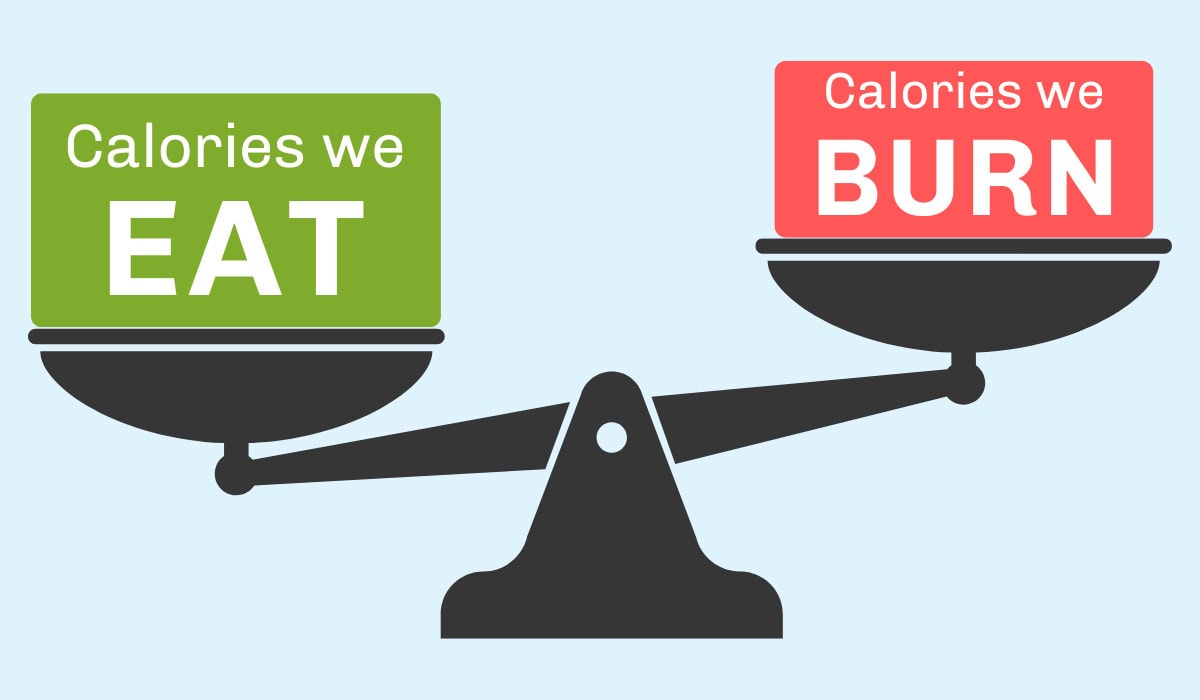
In order to lose weight you have to be in what’s called a calorie deficit. Put simply, you have to consume less calories than you need to lose weight.
And you might be thinking, ‘how many calories do I need to eat’ to do this?
For a female you need to eat about 1,500 calories a day to lose weight, although this number might actually be less depending on your activity levels and age.
As a man you need about 1,800 calories a day to lose weight. Same goes with activity levels and age.
So that part is simple. The difficult part is actually doing it. Staying full, staying satisfied, staying energized without feeling cranky seems almost impossible to achieve.
The most important thing when it comes achieving your weight loss goals is long term consistency. And the best way to achieve that is to have a healthy diet which you can enjoy and stick to.
These weight loss tips aim to keep you feeling full and satisfied and most importantly –
Get enough protein!
Protein is brilliant for weight loss because eating protein triggers hormones which cause satiety – in short, it makes us feel full.
So if you’re lacking protein in your diet you’re much more likely to want to eat more in your meal or to snack afterwards (of course we make sure our meal plan recipes are high in protein).
Not only that but protein contributes to muscle mass and maintenance and while we won’t go into that too much today, this can help with weight loss because it means our body is more metabolically active.
The more muscle we have, the more calories our body needs a day. So in terms of weight loss? It makes weight loss ‘easier’ if you have more muscle!
Our top tips regarding protein intake:
- Space your protein intake out evenly over the day! Don’t just have a protein heavy lunch or dinner!
- Try to eat different sources of protein in each meal (eg. breakfast: Greek yogurt, lunch: scrambled eggs, dinner: black bean soup)
- Aim for between 60-100 grams of protein per day*
* Vegetarian Protein: An Honest Note
It’s not always easy to get lots of protein as a vegetarian. 60-100g of protein per day is more difficult without the use of protein shakes or repetitively eating the same food. This is especially true while trying to lose weight.
Vegetarians have to try a bit harder than omnivores to find a balance between optimum protein amounts and interesting, diverse meals.
You definitely still CAN lose weight with less than 60g protein per day, it’s just not 100% ideal.
So, if you want to get beyond 60g of protein on a low calorie plan (eg. 1500kcal/day), what are your choices?
- Use protein shakes or other low calorie high protein snacks. That allows you to still get to eat varied meals.
- You double down on vegetarian low calorie high protein sources. Think soy products, low fat cottage cheese, Greek yogurt and eggs. That way you could avoid protein shakes, but have much less varied meals.
Or you could stick to a varied diet and skip the protein shake. You’d accept that it just might not be ‘gold standard’ regarding protein intake, but you can still lose weight healthily.
Have a look at the picture below to help guide you with some vegetarian sources of protein!
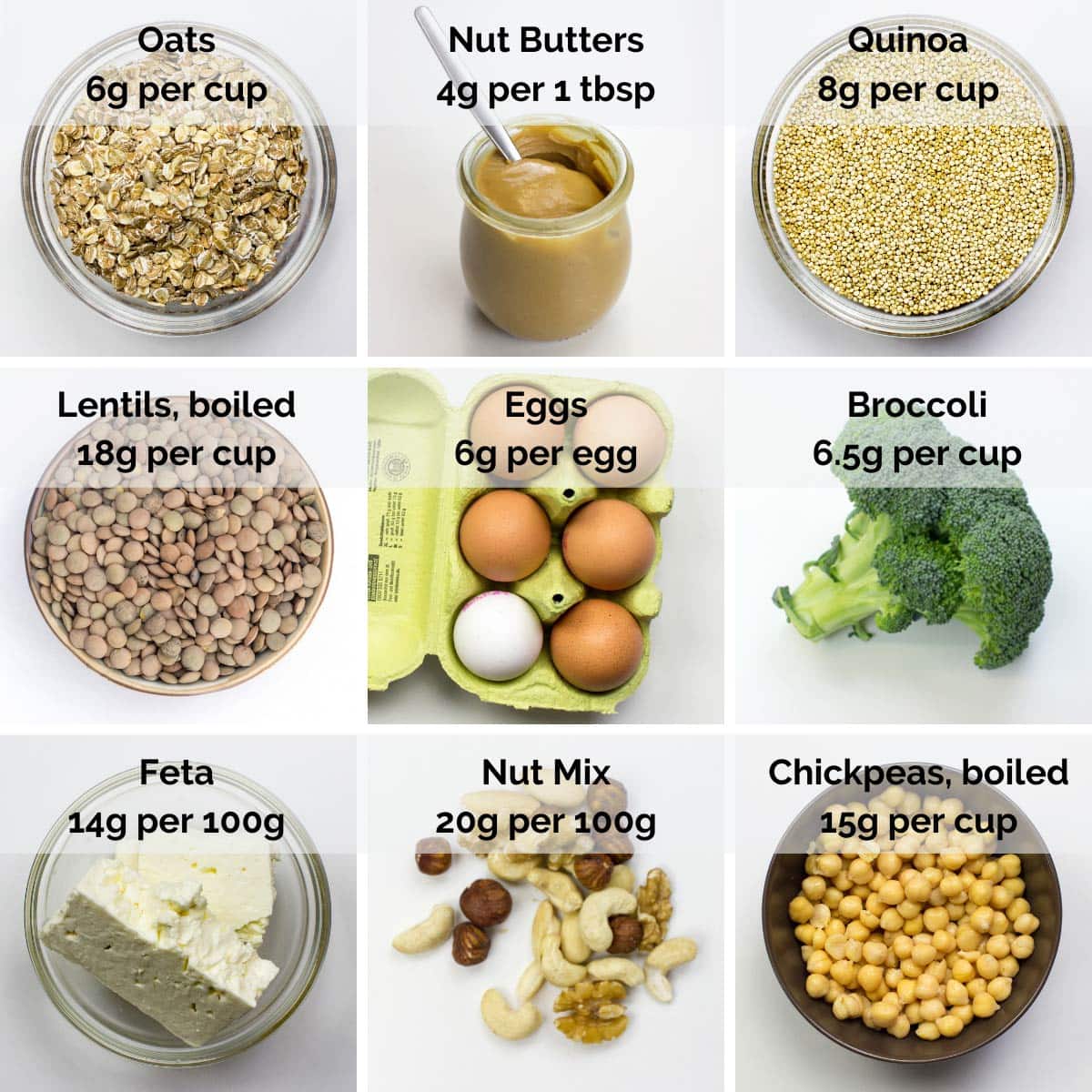
Full fat vs low fat dairy
An ever-popular question… Should you eat high or low fat dairy foods for weight loss?
Our opinion here is that eating low fat milk products the majority of the time is helpful for vegetarian weight loss.
The reason here is quite simple and straightforward: it’s all about the numbers.
1 gram of fat contains 9 calories. 1 gram of carbohydrates or protein contains 4 calories. Fat doesn’t help with feeling full, but protein and carbohydrates (which usually contain fibre) do help.
So by eating lower fat products you can either eat more total food for the same amount of calories, or eat the same total volume of food for less calories. And you eat more of the satisfying foods.
Seems like a no brainer really, doesn’t it?
This is even more important for vegetarians, because this is essentially the vegetarian version of ‘lean meats’.
Meat eaters do have it a little bit easier when it comes to protein intake because they could eat a low fat piece of meat and get a lot of protein and no added calories as fat or carbohydrates.
The concept here is similar – eat lower fat dairy products and get more protein… Who needs lean meat when you’ve got low fat dairy at your side!
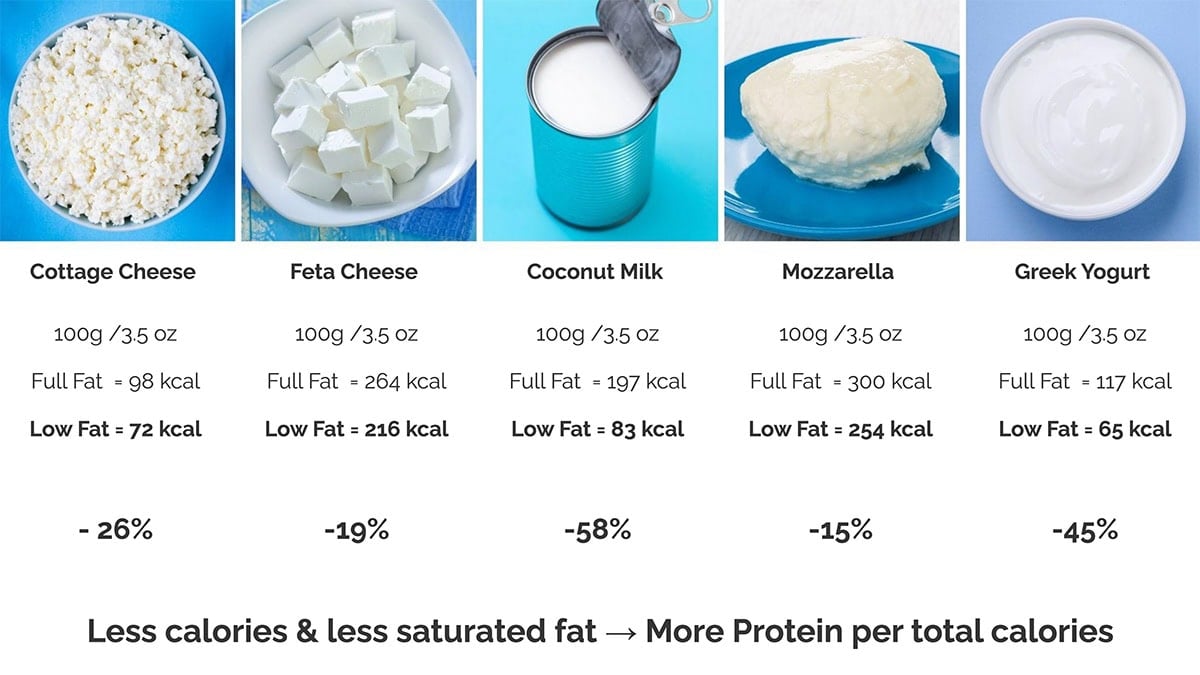
Our low fat dairy tips:
- Try some of the swaps out from above. Our favorite, and arguably the most useful, is using low fat greek yogurt and combining it with something like blueberries or strawberries.
- Don’t worry about ‘losing flavour’! With the right recipe or pairings this shouldn’t be the case. For example, why don’t you try low fat coconut milk in our chickpea curry?
Healthy, delicious carbs
Carbs get a bit of a bad reputation sometimes. But, carbohydrates for weight loss are actually brilliant – you’ve just got to pick the right ones!
Wholegrain carbohydrates contain healthy nutrients like iron and calcium, and contain lots of fiber and protein so actually help us to feel full.
Fruits and vegetables also come under the ‘carbohydrate’ bracket, and we definitely don’t want to remove them!
Starchy vegetables like potatoes contain more calories than non starchy vegetables like carrots or peppers.
These non starchy vegetables are brilliant pairings to main dishes or as a snack with hummus because they help to make the dish feel more complete and filling but don’t add in lots of calories.
We’ve also compiled a list of the best fruits for weight loss too, and you can give that a read for some more motivation!
Top tips for carbohydrates:
- If you haven’t really eaten whole grain carbohydrates before then you can start by using 50% whole grains, 50% white. This works great for partners or families too!
- Don’t ditch the starchy carbs, they’re great for us!
- Non starchy carbs are great additions to any meal or snack for helping to feel full.
- Fresh fruits are better than dried fruits: much more “volume” for the same amount of calories
Dietary Fiber
Fiber is another fantastic tool when it comes to losing weight (and for our health!). Technically fiber is a type of carbohydrate. What differentiates fiber to other carbs is that the body can’t digest it.
There are two types of fiber: soluble and insoluble. While we don’t need to go into that too much, what you need to know is that fiber is good for us and the average diet doesn’t contain anywhere near enough of it!
Fiber helps with weight loss because it also contributes to feeling full – by taking up a lot of space in our tummy.
But while high fiber foods take up a lot of space they don’t contain many calories – meaning you can feel full for less calories.
Our top tips for fiber:
- 10 grams of fiber per meal
- 30-40 grams of fiber per day. By switching to some whole grain products and including legumes to your diet you should get there effortlessly (think brown rice, black beans, avocado).
- If you find you produce a lot of gas when you increase your fiber intake then don’t worry! This is normal. Reduce the amount of fiber and then build up again and you should find this settles.
How many calories should I eat?
Ok, great question. It’s all well and good giving you all this information on foods to eat for weight loss, but how much should you actually eat a day?
Below you’ll find our guide for females and males. This is based on a moderately active person who does 30 minutes of exercise 5 days a week. If you don’t do that or have a very sedentary job then you might need to eat less for weight loss.
If you are more active then you may need to eat a bit more per day to make sure you lose weight safely. Check out this calorie calculator to better determine your food intake.

How much weight can I realistically lose?
So let’s address the question of how much weight you can lose in a month because it’s an important topic.
In realistic terms, we are aiming for somewhere between 0.5kg-1.0kg of weight loss per week, which equates to between 2-4 kilos of weight loss per month. In pounds that’s about 4-8 lbs per month.
If you want to follow a vegetarian diet plan to lose weight in a month it’s all about consistency. You need to be able to stick to your plan without falling off the wagon and going back to old habits.
By aiming for slow but steady weight loss and putting all the things we’ve written about today into practice you’re much more likely to be able to stick to your vegetarian weight loss plan and lose weight successfully!
Starting the Vegetarian Weight Loss Journey
Part 1: Out with the old
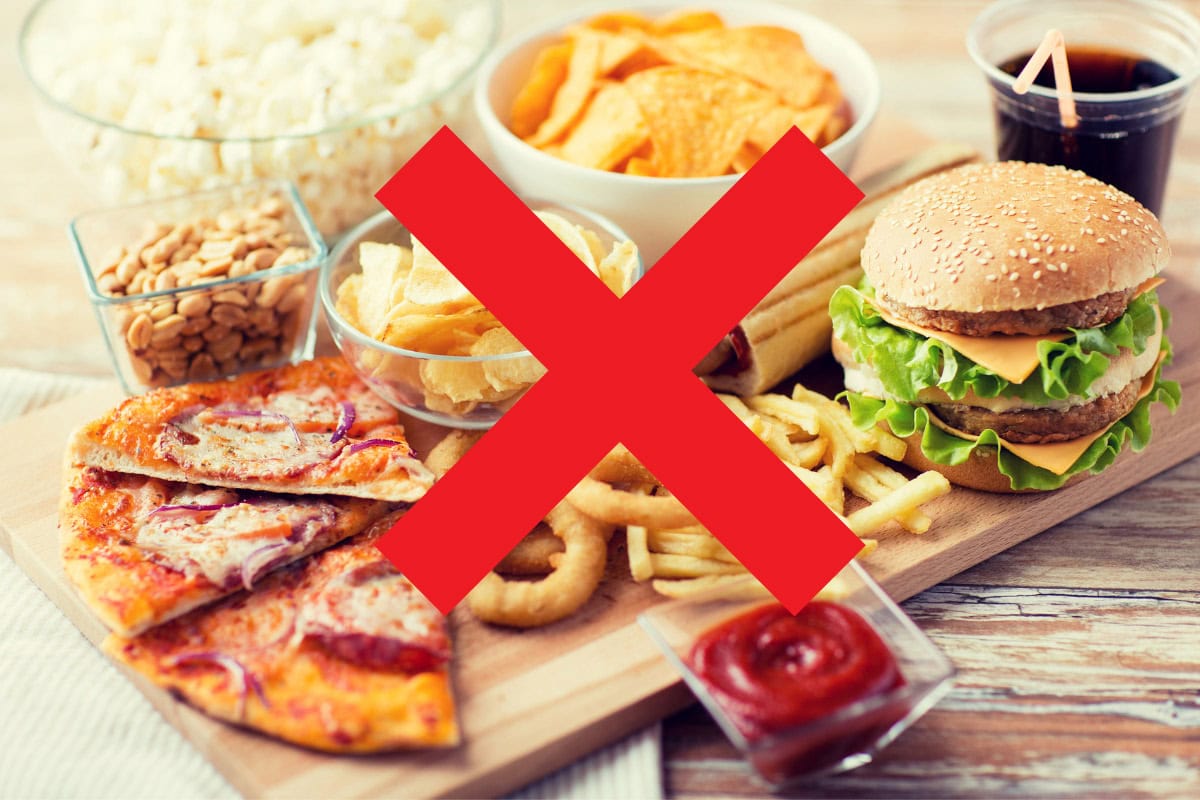
We’re no fans of throwing food in the bin. But it’s important that you don’t stock up on certain things.
As you surely know, we all have our weaknesses for certain naughty foods, and if they are in the house we are much more likely to give in to temptation.
That would be a shame for our weight loss efforts.
Follow these tips and you’ll be sure you automatically eat more whole foods and reduce calorie intake a lot.
Fats
Use less highly processed fats like margarine and cheap oils like canola or sunflower oils
Meat
Stop purchasing meats of all kind, especially the highly processed ones like sausages and sandwich slices.
Snacks
Avoid stocking up on sugary snacks like donuts, milk chocolate, cookies and sweets. Also skip the potato chips and salted nuts.
Dressings and Sauces
Walk past heavy caloric products like mayonnaise, ketchup, french dressings and alike.
Drinks
Store bought sodas and iced teas usually are high in calories. Fruit juices are naturally high in calories too. Cut down on these products.
Also important: read nutrition labels!
You’ll be surprised how many calories you find in a single bottle of soda or in a cup of seemingly healthy fruit yogurts. Make sure to always check the serving sizes as well. Many companies are sneaky and recommend super small serving sizes in order to bring the calorie count down.
Don’t let them fool you! You’ll get good at reading labels quickly.
As an example check out these Haribo Goldbears (not vegetarian, actually). To figure out how many calories are in this pack you have to do quite some math: 4.5 times 100 = 450 kcal. Now to be able to compare this to other snacks it would be better to know the calories per 100g: 450 kcal / 142g * 100 = 316 kcal per 100g. All in all quite naughty to say the least.
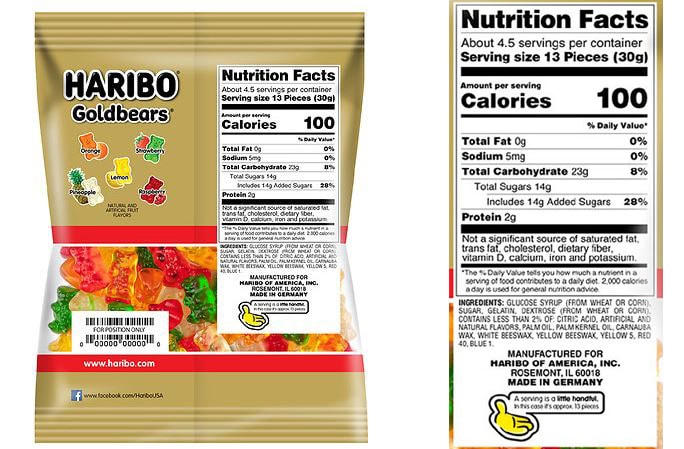
Part 2: In with the new
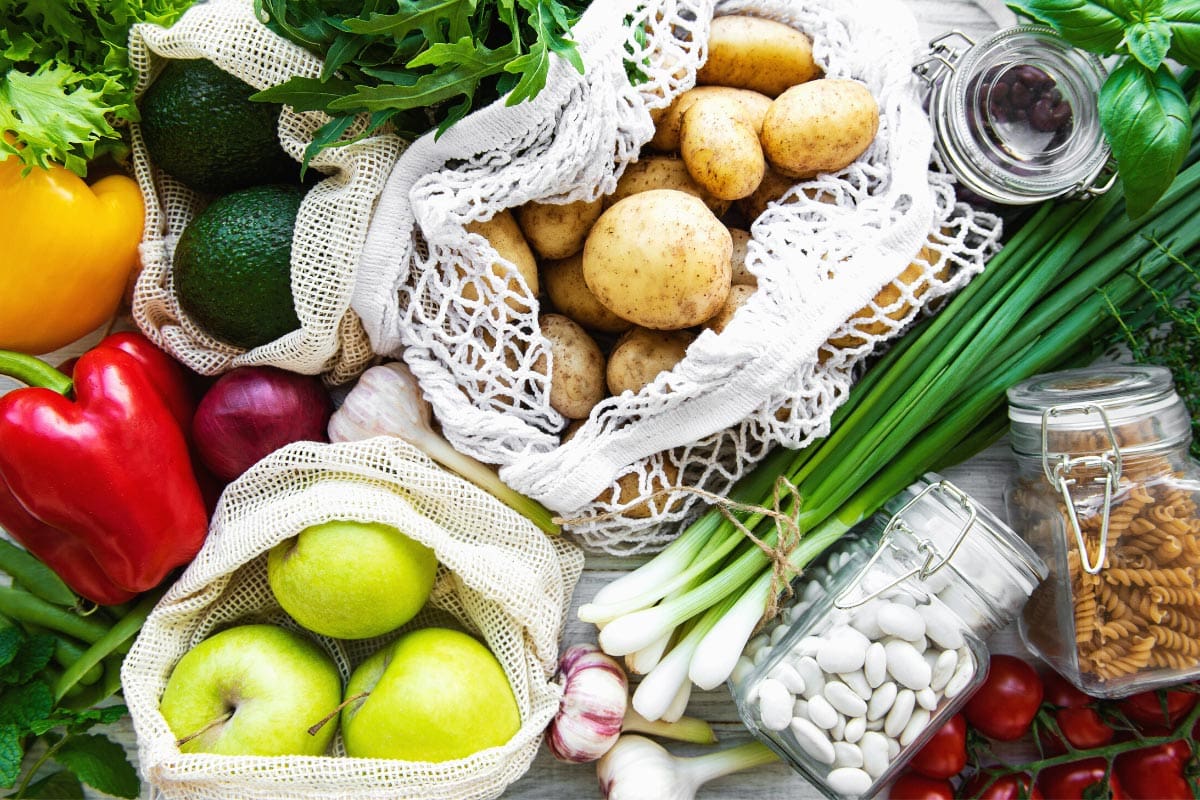
Now you might feel slightly disappointed to see so many of your favourite groceries banned from your kitchen.
Well, the good news is that the vegetarian diet is not about abstaining, but about changing food staples.
Let’s go:
Fats
Use more of the less refined fats like butter, olive oil and coconut oil. Swap ‘standard’ peanut butter made with palm oil for natural nut butters.
Meat replacements?!
Going vegetarian doesn’t mean to just leave out meat or replace meat with a meat substitute. It’s more about discovering new recipes.
If you are worried about protein and B12, then vegetarian foods like chickpeas, beans, lentils, tofu, eggs, halloumi cheese, feta and mozzarella are excellent sources.
Snacks
Stock up on dried fruits, nuts, seeds, homemade popcorn, and dark chocolate.
Dressings and Sauces
Make your own dressings or at least get some low calorie store bought dressings and use them in moderation.
To Drink
Go for various teas, water and coffee.
Our vegetarian weight loss meal plan has all this incorporated, so you can easily follow along, stress-free.
Frequently Asked Questions
Is this weight loss diet plan healthy?
Yes. This plan is carefully constructed to make sure we get all essential nutrients. We take great care to make sure you get plenty of protein, while also getting fatty acids, healthy fats, essential amino acids and lots of vitamins and nutrients.
Animal protein (through animal products like eggs and dairy) is included, as is plenty of plant-based proteins.
We also keep the saturated fat down to guideline levels, and we generally stay away from meat substitutes as they are often very heavily processed.
This plan is carefully checked by James, our Nutritionist. He is also in charge of staying on top of the latest research and guidelines, so you can be sure this plan is up to date, and indeed healthy.
What if I don’t want to prep all meals?
If you don’t like some recipes or just want to skip breakfast – no problem. Just cross those off the meal plan.
And since each meal is assigned to a letter you can find all respective ingredients on the shopping list and cross them off as well. That way you won’t buy anything you won’t use. Easy.
For how many people is the meal plan set up?
The meal plan is laid out just for one single person. Also the recipes only call for ingredients to make only one or two servings.
If you want to use the recipes of this meal plan for your partner or whole family you’ll have to multiply the ingredients. You can change this easily on the site.
Are there different meal plans for men and women?
Yep, there are two meal plans. One 1500 kcal/day (women) and one 1800 kcal/day (men). If you want to calculate your individual calorie intake we recommend modifying the snacks to reach your daily calorie limit.
Alternatively you can always vary the calories of a meal by adding or removing certain ingredients (bread, avocado, etc.) to adjust to your individual level.
When should I start with the vegetarian weight loss meal plan?
Begin whenever you like. How about today?
And what about drinking?
Avoid soft drinks and alcohol. Stick to water (with lemon or mint), tea and coffee without sweeteners for fewer calories!
What should I eat for the weeks after the 7 day meal plan is over?
Easy! Either you repeat our 7 day meal plan, or even better: you customize your own! That’s why we’ve added a meal plan template to the pack as well.
Just copy-paste what you liked from the previous week and add new recipes to the plan (there are loads more ideas here).
Last but not least:
don’t overthink things. It’s ok to skip a meal from the meal plan. For example Hauke almost always has muesli with soy milk for breakfast. (‘Leave me alone with those complicated recipes in the morning, will ya?’).
And if you want to swap a dish from one day to another, that’s fine too! Or maybe you want to make that delish Cauliflower Curry more often? Go for it!
Are vegetarians generally thinner?
According to current research, vegetarians seem to have a lower BMI than their meat-eating counterparts.
There are lots of various different reasons for this and this doesn’t specifically mean a vegetarian diet is healthier.
Do vegetarians lose weight faster?
No. The rate of weight loss is determined by the amount of calories you eat in a day and so being vegetarian doesn’t change this. However, vegetarians following a plant-focused diet will likely find it easier to lose weight.
Life after the meal plan
Your weight loss journey probably won’t end after 7 days of healthy vegetarian recipes. We’re confident many of the recipes can become staples in your household. And then it’s about sticking to them and adding more to the mix!
We’ve got hundreds of recipes online already. Just use the search on our main page. It should be easy to find your next favourite!
Weekly Vegetarian Weight Loss Meals
If you’re interested you can also have a free trial of our weight loss meal plan for vegetarians! We create a new meal plan EVERY WEEK which is designed with weight loss in mind. We do the hard work so you don’t have to. You just have to cook it and eat it!
Before you go, give this meal plan recipe a test!
If you’d like to try out a recipe from the meal plan right away, how about this delicious Arugula Lentil Salad from Heaven?

- Roast the cashews on a low heat for about three minutes in a pan to maximize aroma. Then throw them into the salad bowl.
½ cup cashews
- Dice up and fry the onion in olive oil for about 3 minutes on a low heat.
1 onion, 1 tsp olive oil
- Move the onion mix into a big bowl.
- Meanwhile chop the chilli/jalapeño and dried tomatoes. Cut the bread into big croutons. Add them to the pan and fry for another 2 minutes until the bread is crunchy. The oil from the sun-dried tomatoes should do.
1 chili / jalapeño, 4 sun-dried tomatoes in oil, 3 slice wholegrain bread
- Season with salt and pepper.
Salt and pepper to taste
- Wash the arugula and add it to the bowl. Add the raisins.
1 handful arugula/rocket, 1 small handful raisins
- Put the lentils in too. Season with salt, pepper, maple syrup and balsamic vinegar. Finally, serve with the croutons mix.
1 cup brown lentils, cooked, 1 tsp maple syrup, 2 tbsp balsamic vinegar
- Super tasty!
Nutrition Facts
Free 7-Day Vegetarian Weight Loss Meal Plan
Amount per Serving
% Daily Value*
* Percent Daily Values are based on a 2000 calorie diet.
Disclosure
We would like to take a moment to note that this post is for information purposes only. It does not claim to provide medical advice or to be able to treat any medical condition. It makes no claims in respect to weight loss, either in terms of the amount or rate at which weight loss could be achieved. If you have any concerns regarding your health please contact your medical practitioner before making changes.


